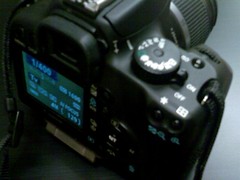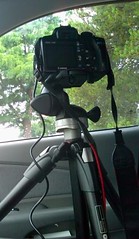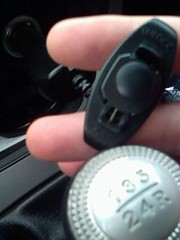Some people have expressed concern about my taking photos while driving. The tagline of Fast Fotos, Distracted Driving on this blog probably doesn't help. :) The tagline is purely tongue-in-cheek. I am careful to not let picture taking distract me from driving.
As a former driving safety instructor, I am well aware of how distractions can contribute to crashes. One of the central themes of the classes I taught was that driver attitude can have a greater impact on (un)safe driving than driver skill. Crashes are more likely to happen due to attitude than driving skill -- and one could argue that not gaining necessary skill is an attitude problem.
So back to my photos...















Only 4 of the above photos were taken while in motion
-- and 1 of the 4 was taken while barely rolling at about 1 mph.
I take many of my Commuter Camera photos when I am not driving. I take them as a passenger, on foot, or after pulling off the road. So, how do I safely capture images for Commuter Camera?
As a former driving safety instructor, I am well aware of how distractions can contribute to crashes. One of the central themes of the classes I taught was that driver attitude can have a greater impact on (un)safe driving than driver skill. Crashes are more likely to happen due to attitude than driving skill -- and one could argue that not gaining necessary skill is an attitude problem.
So back to my photos...















Only 4 of the above photos were taken while in motion
-- and 1 of the 4 was taken while barely rolling at about 1 mph.
I take many of my Commuter Camera photos when I am not driving. I take them as a passenger, on foot, or after pulling off the road. So, how do I safely capture images for Commuter Camera?
- Know the equipment. Do not let yourself be distracted fiddling with your camera. Set up your camera before you start driving. Have your camera ready and know how to use it well. Don't get distracted finding your camera, turning it on, and setting the right mode. I use four different cameras for Commuter Camera: an SLR, my cell phone, and two megazoom point & shoot cameras. If I am planning to take photos, I prepare the one camera I want to use before I get on the road. Taking photos while driving hopefully does not require pressing more than a power and shutter button that you can find by feel.


- Know when to not shoot. Don't shoot in heavy traffic. Don't let photo taking be even the tiniest distraction in heavy traffic. Don't shoot while navigating turns. Don't take photos while tailgating. Better yet: don't tailgate. Travel at a safe distance from the vehicle in front of you. Stay at least 3 seconds behind the car in front of you. If you know you are distracted or expect drivers around you to make erratic moves, put the camera down and give yourself even more reaction space/time. There is a good reason why most of my handheld shots while in motion and behind the wheel are on straight highways in light traffic: I'm not going to risk my safety, or that of those around me, to take a photograph. This means I don't get lots of photos I'd really like to have captured.

- Pull off the road and stop. Get off the road to take photos. Stopping on the shoulder of a limited-access highway for non-emergency purposes is generally illegal here in the US. So, I often exit the highway and find a safe place to stop and take photos. Once, while stopped alongside a side road, a deputy sheriff pulled up behind me and turned on her lights. She startled me; but it turns out she was just checking to see if I needed any help. I told her I was taking pictures and making a phone call, and she went on her way. :)
- Don't look through the viewfinder. Do not look through a camera's viewfinder while driving. That's a great way to get dangerously distracted. Even avoid looking at LCD viewfinder screens on the back of your camera. Don't even take your eyes off the road to look at whatever you want to photograph. When holding a camera by hand, I just point it in the general direction and hold down the shutter button. And don't review the photos you take while you are still driving. Digital photography makes it easy to crop and otherwise manipulate your images when you are safely parked in front of your computer.

- Use continuous shooting mode. When not carefully framing a shot through the viewfinder, it is difficult to get the intended target. I increase my chances of getting a good photo by using continuous mode. My SLR, phone camera, and point & shoot cameras all have a mode that takes continuous bursts of photos. I'll shoot a burst of photos and look at them later when I'm not driving. There are usually dozens of bad photos for every one I deem good enough to share.


- Use a tripod and remote shutter release. I occasionally set up my camera on a tripod and use a remote shutter release to snap the photos. If you try this, ensure that the tripod is stable and will not fly into your face as you round a corner or dodge another driver that cuts you off. I've found it helps to have no more than one leg of the tripod resting on a soft seat. With the remote shutter release and pre-aimed camera, I can easily take photos without looking away from the road.



Please don't do anything that is unsafe, is beyond your abilities, or is illegal wherever you drive.
Above all, understand that safety is your first priority while driving. It isn't getting to your destination. It isn't engaging in conversation with your passengers. It isn't yelling at a talking head on the radio. It isn't taking photos. Be alert. Be safe.
Above all, understand that safety is your first priority while driving. It isn't getting to your destination. It isn't engaging in conversation with your passengers. It isn't yelling at a talking head on the radio. It isn't taking photos. Be alert. Be safe.
If you get any good photos on your commute, please share them. I have created a Commuter Camera group on Flickr at http://www.flickr.com/groups/commutercamera/.


No comments:
Post a Comment